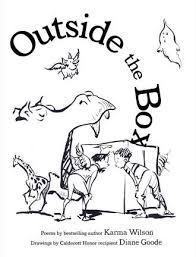National Poetry Month: Guest Post from Karma Wilson: The Gateway Drug to Poetry
When I visit school children I ask kids to raise their hands if they like poetry. The response varies, but usually only a few ever do. It’s discouraging on the face of things, but usually by the time I leave when I ask the question again, all the kids raise their hands. You see, the fact of the matter is that most children, and in fact most people, do enjoy poetry…they just haven’t realized it.

Margaret K. McElderry Books, March 2014.
After I pose that question, I then ask another question. “How many of you like songs on the radio or ipod?” The show of hands SKY ROCKETS, and almost every hand is now proudly waving in the air. This is when I “get” them. “But wait a minute, a bunch of you said you don’t like poetry. Songs with words ARE poems set to music.”
I then add all the other places you may find poems. Video games that incorporate role-play often have poems scattered through the gameplay and quests. Slogans for catchy ads are really just small poems. Rap is poetry. Jump rope chants are poetry. Poetry is everywhere.
Children are scared of poems because they think they are strictly cemented in an adult world—a world of dry lines, words they don’t understand, or content that isn’t aimed to their interests. Getting kids to like poetry is a little like getting a baby switched to solid food—you don’t start them on steak and potatoes. Instead, you give them food more suited to their young palettes and nutritional needs. Kids don’t need to be taught to love poetry; they need to be taught that they probably already do love poetry.
Music is often a child’s first introduction to poetry, even prior to books. Music is heard in the womb, it’s often played in the home, and adults in their life passing the time sing it. Music has a “cool” factor that can help break down a child’s leeriness of poetry. Music is a great tool for teachers, librarians, and parents to use in their literacy arsenal.
So how? Well, a great way is to ask kids to name a few songs they love, and then look up the song and lyrics (sometimes you may have to search for a “clean” version of the song). Now play the song in class (this is the fun part—I encourage you to let them dance, whoop it up, and enjoy the experience.) Then take those lyrics, write them in poetry form, and break it down for them. In my example I’ll use lyrics from a song that used to be very popular, and is kid friendly and catchy, “Fireflies” by Owl City. So here’s a verse from that song:
‘Cause I’d get a thousand hugs
From ten thousand lightning bugs
As they tried to teach me how to dance
A foxtrot above my head
A sock hop beneath my bed
The disco ball is just hanging by a thread
Wow, what a wealth of poetry lessons in ONE VERSE! Yay! What are some topics that could be covered aside from the obvious rhyme: Word play, puns, metaphor, how accents affect rhythm and flow.
Start by reciting the chosen verse without the music. Read it straight-faced, little emphasis on words, just a clean, boring read. Then point out how boring that sounded compared to the verse with music. Explain that poems, like songs, stories, and movies, are best when “performed” not just read. Then “perform” the poem (this doesn’t require you to sing, no worries….).
By perform, I mean recite with emphasis, life, humor, and emotion. For the verse I chose I would do something like this:
‘Cause I’d get a thousand hugs (Emhasis on the word “thousand” and I’d use my arms to hug myself.)
From ten thousand lightning bugs (even MORE emphasis on the words “ten thousand, and I’d use finger play to indicate the “fireflies).
As they tried to teach me how to dance (I’d raise my eyebrows quizzically at the idea of fireflies teaching me how to dance, and do a few impromptu dance moves…)
A foxtrot above my head (I’d look up, as if asking “Where’s the fox?” )
A sock hop beneath my bed (I’d shrug and raise my hands as if asking, “What? Really?)
The disco ball is just hanging by a thread
From there let the discussion role! Kids love breaking down poems, and discussing word choices. They love being asked their opinion. They love feeling that what is important to them is important to YOU as well.
By using songs in your poetry lessons you can make music the “gateway drug” to a life long love of poetry.

Karma Wilson.
Karma Wilson’s picture books include the international bestseller BEAR SNORES ON, BEAR WANTS MORE, BEAR STAYS UP FOR CHRISTMAS, and MORTIMER’S CHRISTMAS MANGER, all illustrated by Jane Chapman; A FROG IN THE BOG, illustrated by Joan Rankin; HILDA MUST BE DANCING and BEAR HUGS, illustrated by Suzanne Watts; and WHO GOES THERE?, illustrated by Anna Currey. She lives with her family in Fortine, Montana. Visit Karmaat KarmaWilson.com.








